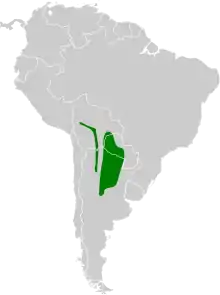Olive-crowned crescentchest
The olive-crowned crescentchest (Melanopareia maximiliani) is a species of bird in the family Melanopareiidae. It is found in Argentina, Bolivia, and Paraguay.[2]
| Olive-crowned crescentchest | |
|---|---|
 | |
| Scientific classification | |
| Domain: | Eukaryota |
| Kingdom: | Animalia |
| Phylum: | Chordata |
| Clade: | Dinosauria |
| Class: | Aves |
| Order: | Passeriformes |
| Family: | Melanopareiidae |
| Genus: | Melanopareia |
| Species: | M. maximiliani |
| Binomial name | |
| Melanopareia maximiliani (D'Orbigny, 1835) | |
 | |
Taxonomy and systematics
The crescentchests (genus Melanopareia) were previously included in family Rhinocryptidae, the tapaculos. A 2010 publication confirmed earlier work and created their present genus.[3][4] The olive-crowned crescentchest has three subspecies, the nominate Melanopareia maximiliani maximiliani, M. m. argentina, and M. m. pallida. The last has been suggested as a separate species due to vocal differences.[5] In addition, a subpopulation of M. m. pallida might be an undescribed taxon.[6]
Description
The olive-crowned crescentchest is 15 cm (5.9 in) long. Males weigh 17.1 to 18.0 g (0.60 to 0.63 oz), one female weighed 16.7 g (0.59 oz), and unsexed specimens weighed 16.9 to 18.2 g (0.60 to 0.64 oz). The nominate subspecies' crown and upperparts are olive-brown, the throat deep buff, and the chest and belly ochraceous. It has a narrow buff supercilium with a black mask below and a black crescent and chesnut band between the throat and chest. M. m. argentina is similar but has paler underparts. M. m. pallida is paler still, its throat is more cinnamon than buff, and the facial mask is a lighter black.[7]
Distribution and habitat
The nominate subspecies of olive-crowned crescentchest is found in La Paz Department of western Bolivia. M. m. argentina is found from central Bolivia to northwestern Argentina. M. m. pallida is found in southeastern Bolivia, western Paraguay, and northern Argentina. The species generally inhabits dry scrub and grassy areas with small bushes, but M. m. pallida also frequents sawgrass in the Chaco Basin. It ranges in elevation mostly from 1,700 to 2,950 m (5,580 to 9,680 ft) but is found as low as 1,200 m (3,900 ft) in Argentina.[7]
Behavior
Feeding
The olive-crowned crescentchest usually forages alone, but sometimes in pairs, by hopping through dense cover on or near the ground. Its diet has not been recorded.[7]
Breeding
In Argentina the olive-crowned crescentchest breeds from September to December; an active nest was found in October in central Bolivia. Two nests of M. m. pallida were cups of vegetable fiber and palm leaves; they were hidden not far above the ground. One nest of M. m. argentina was a tunnel lined with grass. The species' clutch is two or three eggs.[7]
Vocalization
The nominate olive-crowned crescentchest and M. m. argentina have two songs, one described as "chuck" notes and the other as "chi" notes . The song of M. m. pallida is faster . The species' call is described as "chit chuck" .[7]
Status
The IUCN has assessed the olive-crowned crescentchest as being of Least Concern.[1] It is locally fairly common and in Argentina occurs in several protected areas.[7]
References
- BirdLife International (2016). "Olive-crowned Crescentchest Melanopareia maximiliani". IUCN Red List of Threatened Species. 2016. Retrieved 3 May 2021.
- Gill, F.; Donsker, D.; Rasmussen, P. (January 2021). "IOC World Bird List (v 11.1)". Retrieved January 14, 2021.
- Remsen, J. V., Jr., J. I. Areta, E. Bonaccorso, S. Claramunt, A. Jaramillo, D. F. Lane, J. F. Pacheco, M. B. Robbins, F. G. Stiles, and K. J. Zimmer. Version 19 January 2021. A classification of the bird species of South America. American Ornithological Society. https://www.museum.lsu.edu/~Remsen/SACCBaseline.htm retrieved January 19, 2021
- Ericson, P.G.P.; Olson, S.L.; Irestedt, M.; Alvarenga, H.; Fjeldså, J. (2010). "Circumscription of a monophyletic family for the tapaculos (Aves: Rhinocryptidae): Psiloramphus [sic] in and Melanopareia out". Journal of Ornithology. 151: 337–345.
- Krabbe, N., and T. S. Schulenberg. 2003. Family Rhinocryptidae (Tapaculos). Pp. 748–787 in “Handbook of the Birds of the World, Vol. 8. Broadbills to tapaculos." (J. del Hoyo, A. Elliot, and D. A. Christie). Lynx Edicions, Barcelona.
- Boesman, P. (2016). Notes on the vocalizations of Olive-crowned Crescentchest (Melanopareia maximiliani). HBW Alive Ornithological Note 67. In: Handbook of the Birds of the World Alive. Lynx Edicions, Barcelona.
- Krabbe, N. and T. S. Schulenberg (2020). Olive-crowned Crescentchest (Melanopareia maximiliani), version 1.0. In Birds of the World (J. del Hoyo, A. Elliott, J. Sargatal, D. A. Christie, and E. de Juana, Editors). Cornell Lab of Ornithology, Ithaca, NY, USA. https://doi.org/10.2173/bow.olccre1.01 retrieved May 3, 2021
